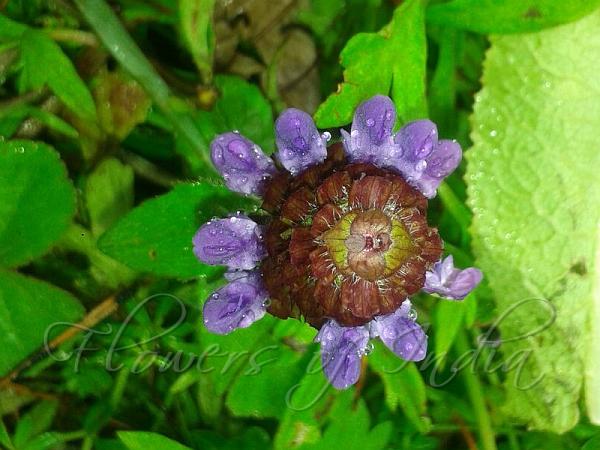|
| Common Self-Heal |
|

|

|
|
|
|
Photo: |
Botanical name: Prunella vulgaris Family: Lamiaceae (Mint family)
Common Self-Heal is a herb found on the meadows and open slopes of the
Himalayas, from Afghanistan to Bhutan. Flowers are bright blue-violet,
rarely pink or white, up to 1.5 cm long. They are borne in whorls of 6.
Flowers are 2-lipped and tubular, the top lip is a purple hood, and the
bottom lip has three lobes with the middle lobe being larger and fringed.
Sepal cup is also tubular and 2-lipped, purplish. The inflorscence
contains many purplish overlapping bracts. Stems are 10-30 cm long,
creeping or rising. Leaves are ovate or ovate-oblong, 1.5-6 × 0.7-2.5 cm.
There is a pair of leaves just below the inflorescence. Common Self-Heal
is found at altitudes of 1500-3600 m. Common Self-Heal was once proclaimed
to be a holy herb and was thought to be sent by God to cure all ailments
of man or beast. It was said to drive away the devil, which lead to the
belief that Heal-All was grown in the Witches garden as a disguise. The
root was also used to make a tea to drink in ceremonies before going
hunting by one Native American tribe to sharpen the powers of observation.[
Flowering: May-September.
Medicinal uses: Heal-all is both edible and medicinal. It can
be used in salads, soups, stews, or boiled as a pot herb. It has been used
as an alternative medicine for centuries on just about every continent in
the world, and for just about every ailment. Heal-All is something of a
panacea, it does seem to have some medicinal uses that are constant. It
is taken internally as a medicinal tea in the treatment of fevers,
diarrhoea, sore mouth and throat, internal bleeding, and weaknesses of the
liver and heart.
Heal-all is both edible and medicinal. It can
be used in salads, soups, stews, or boiled as a pot herb. It has been used
as an alternative medicine for centuries on just about every continent in
the world, and for just about every ailment. Heal-All is something of a
panacea, it does seem to have some medicinal uses that are constant. It
is taken internally as a medicinal tea in the treatment of fevers,
diarrhoea, sore mouth and throat, internal bleeding, and weaknesses of the
liver and heart.
Medicinal uses:
 Heal-all is both edible and medicinal. It can
be used in salads, soups, stews, or boiled as a pot herb. It has been used
as an alternative medicine for centuries on just about every continent in
the world, and for just about every ailment. Heal-All is something of a
panacea, it does seem to have some medicinal uses that are constant. It
is taken internally as a medicinal tea in the treatment of fevers,
diarrhoea, sore mouth and throat, internal bleeding, and weaknesses of the
liver and heart.
Heal-all is both edible and medicinal. It can
be used in salads, soups, stews, or boiled as a pot herb. It has been used
as an alternative medicine for centuries on just about every continent in
the world, and for just about every ailment. Heal-All is something of a
panacea, it does seem to have some medicinal uses that are constant. It
is taken internally as a medicinal tea in the treatment of fevers,
diarrhoea, sore mouth and throat, internal bleeding, and weaknesses of the
liver and heart. | Identification credit: G. S. Rawat & Pankaj Kumar | Photographed in Arunachal Pradesh, Valley of Flowers, Uttarakhand & Chamba, HP. |
• Is this flower misidentified? If yes,